This publication is part of a series titled Contaminants in the Urban Environment. This series is intended to give state and local government officials, soil scientists, consulting engineers, extension agents, and citizens (1) a basic understanding of the occurrence, toxic effects, and source of various contaminants in the environment and (2) guidance on ways to protect human and environmental health.
Introduction and Purpose
Pharmaceuticals are products that we ingest or give to our pets and domesticated animals to improve health and to prevent or treat human and animal diseases. Pharmaceuticals include over-the-counter drugs, prescription medicines, nutritional supplements, and veterinary drugs.
Personal care products are products used to improve the quality of daily life by adorning and cleaning our bodies. Personal care products include lotions, fragrances, shampoos, antibacterial soaps, detergents, sunscreens, insect repellents, and cosmetics.
Together, these products are known as pharmaceuticals and personal care products, abbreviated as PPCPs (Figure 1).
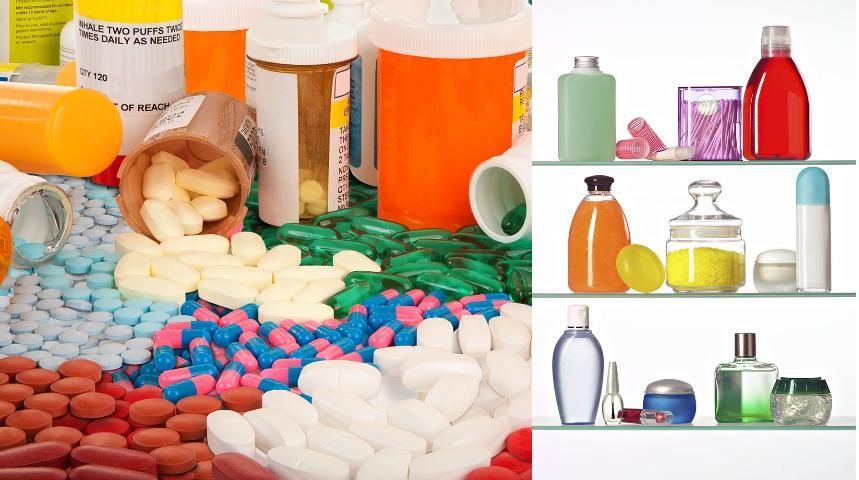
Credit: iStock/Thinkstock.com
This publication, Contaminants in the Urban Environment: Pharmaceuticals and Personal Care Products (PPCPs)—Part 1, provides an overview of the use and sale of PPCPs in the United States and the world. The second publication, Contaminants in the Urban Environment: Pharmaceuticals and Personal Care Products (PPCPs)—Part 2, discusses the sources and impacts of PPCPs as well as the ways to protect our environment from PPCPs (https://edis.ifas.ufl.edu/publication/ss633).
Use of Pharmaceuticals and Personal Care Products (PPCPs)
Pharmaceuticals: Pharmaceuticals can be broadly split into two groups: (1) over-the-counter medications that do not require a doctor's prescription and (2) medications that require a doctor's prescription. In the United States and the rest of the world, most of the medication use (sale) is for the prescription medicines.
(1) Over-the-Counter (OTC) Medications: In 2012, OTC medications (both for oral ingestion and topical use) worth $28.9 billion were sold in the United States. Sales of OTC PPCPs expanded to more than $43 billion in the US in 2023. Cold, pain, and heartburn medications were the top categories (see Table 1).
(2) Prescription Medications: In 2016, global prescription pharmaceutical sales were estimated at $967 billion, with 46% ($446 billion) of those sales occurring in the United States (Lindsley 2017), which is more than 13 times the OTC medications sold that year ($34 billion).
Table 2 shows the top 10 prescription medications sold in the United States ranked by retail sales estimates in 2023. The top 10 medications sold in the United States had a value of about $90 billion, up from $60 billion in 2015. In the United States in 2023, the top three therapeutic classes of pharmaceutical sales were immunology ($90 billion), antidiabetics ($84 billion), and oncologics (anti-cancer drugs; $78 billion; Figure 2). Looking at the worldwide trends, the top three therapeutic classes of medications were oncology, antidiabetics, and immunology.
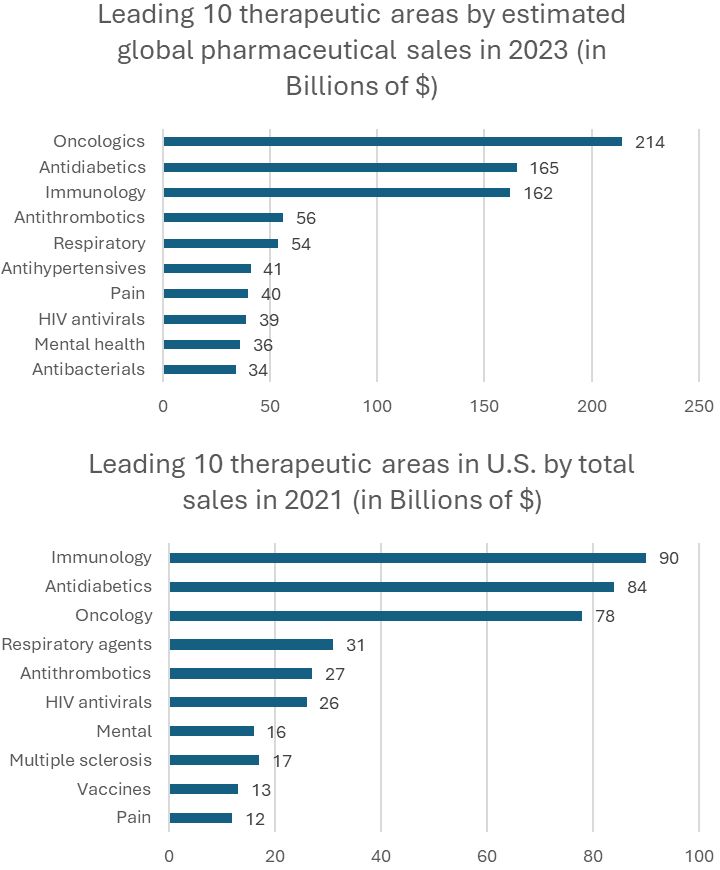
Credit: https://www.statista.com/statistics/279916/top-10-therapeutic-classes-by-global-pharmaceutical-sales/ and https://www.iqvia.com/locations/united-states/blogs/2023/07/insights-into-the-2023-us-pharmaceutical-market
In the US in 2004, there were 3.5 billion prescriptions filled, or 11.9 prescriptions filled per person (Muson and Townsend 2009), and more recent estimates suggest ~6.7 billion prescriptions filled in 2022 (IQVIA 2023). The types of prescription medications most commonly used in the US vary with age (Gu et al. 2010)—asthma medications for children (ages 0–11), central nervous system stimulants for adolescents (12–19), antidepressants for middle-aged adults (20–59), and cholesterol lowering and high blood pressure drugs for older Americans (60 and older).
The data on medication sales provide some perspective on how we use medications. For example, throughout the last decade the percentage of Americans who indicated they had used one prescription medication in the previous month increased by 4%, the use of multiple prescription medications increased by 6%, and the use of five or more medications increased by 5% (Gu et al. 2010).
Patients using prescription medications varied by age and gender. Data in Figure 3 shows that prescription use increased during the three time periods (1988–1994, 1999–2002, and 2007–2010). For example, men 65 years and older who claimed to have used three or more prescriptions in the previous month was 30% in 1988–1994, but this percentage increased to 45% in 1999–2002 and to 65% in 2007–2010. For women 65 years and order, the use of three or more prescriptions in the previous month was 38% in 1988–1994, and this percentage increased to 55% in 1999–2002 and to 65% in 2007–2010. Based on these statistics, women were more likely to use medications than men (Figure 3). During the three time periods, patient use of prescription medications increased with age: 5% for children, 10%–40% for working aged adults, and 30%–70% for adults aged 65 and over.
Overall, the use of three or more prescription medications in the previous month increased for all age groups of both males and females from 1988–1994 to 2007–2010.
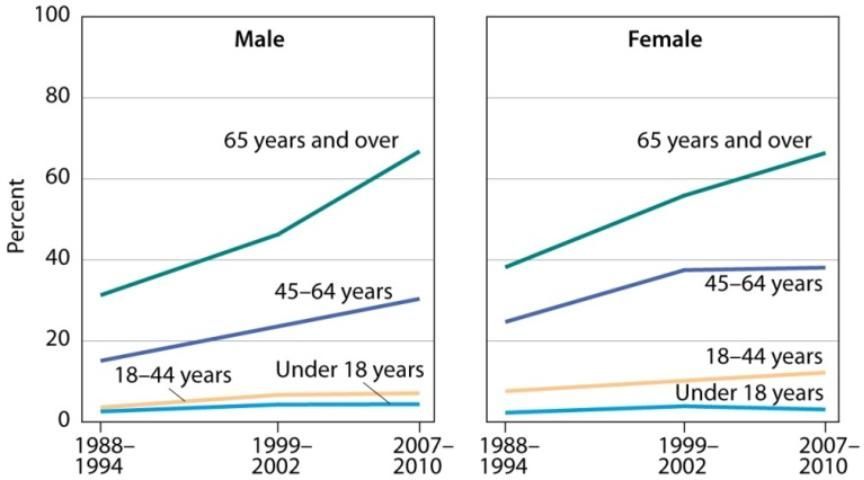
Credit: National Center for Health Statistics (CDC/NCHS). Health, United States, 2012. Data from the National Health and Nutrition Examination Survey
Consider that the United States is home to approximately 5 percent of the total world population and this population uses about 39 percent of total prescription medication sales. Generally, a higher amount of a given medicine is prescribed and used so that there is a sufficient amount of medicine to work in the body and cure the symptoms or disease. A higher amount of medicine intake results in a greater amount of medicine excretion, either as the parent compound or as transformation products (or metabolites) in feces and urine. For example, research shows that of the total medicine taken, about 19%–22% is excreted as parent compound and an additional 3%–49% is excreted as metabolites in the urine and feces (Lienert et al. 2007). Thus, the household wastewater that contains feces and urine ends up containing pharmaceutical compounds and becomes a source of the parent medicine or its metabolites in the environment.
Personal Care Products: Many people use personal care products on a daily basis, be it hair or skin care products. The total global sale of personal care products was $380 billion in 2010. It is estimated that spending on personal care products will continue to grow by 3% per year (Rexam 2011).
As shown in Figure 4, in 2010 worldwide hair care products were the number one seller ($152 billion; 40% of total), followed by bath and shower products ($91 billion; 24% of total), and facial skin care products ($19 billion; 5% of total). In the global market of personal care products, the Asia-Pacific region has the largest share (56%), followed by Europe (19%), Latin America (14%), North America (8%), and Middle East and Africa (2%).
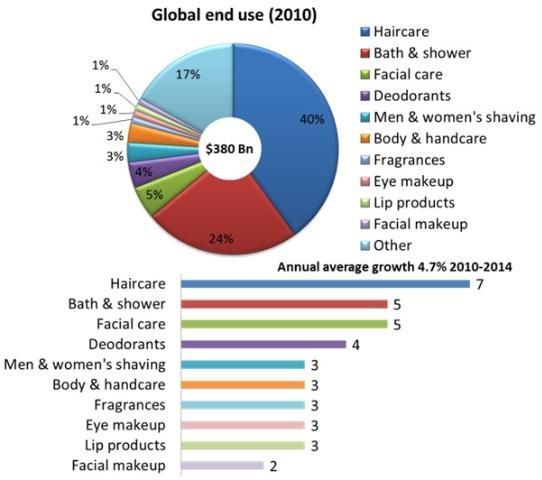
Credit: Rexam (2011)
Figure 5 shows that in the United States in 2013, skin care products sales were $9.8 billion, followed by hair care products ($7.8 billion) and makeup products ($6.5 billion). Note that in comparison to sale of $330 billion on prescription and $23 billion on OTC medications, consumers in the United States spend far less (~$30 billion) on personal care products.
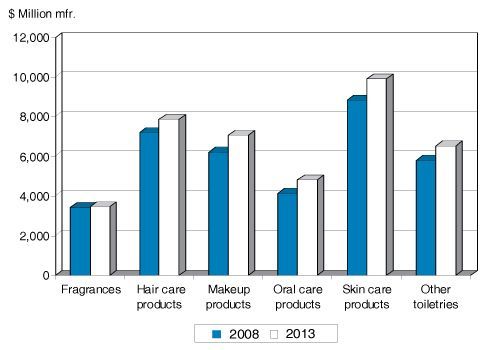
Credit: Kline & Company
Personal care products contain a variety of chemical substances. For example, phthalates are a group of compounds widely used in cosmetics, fragrances, hair products, and shampoo. Triclosan is one example of a widely used antibacterial and antifungal agent. Triclosan is commonly present as an additive in a variety of consumer products, including soaps, deodorants, and toothpastes. For example, liquid soap may contain 0.3 to 0.5 percent of triclosan. In 2017, however, the US Food and Drug Administration (FDA) banned the development and marketing of OTC products that use triclosan and certain other antiseptic compounds, effectively removing tricoslan from the US market. Many of the products, and compounds they contain, enter household wastewater from bath and shower, sinks, and washers and ultimately find their way into the environment. Continuous discharge of wastewater contributes to the accumulation of these substances in the environment.
Because of the presence of these substances, PPCPs discarded into the environment can be harmful to organisms. For example, triclosan and its transformation products have been found in water, plant, and fish samples; and they may have adverse effects on algal communities and aquatic organisms (Wilson et al. 2003). Consult the second publication, Contaminants in the Urban Environment: Pharmaceuticals and Personal Care Products (PPCPs)—Part 2 (https://edis.ifas.ufl.edu/publication/ss633) to learn about these harmful effects along with ways to protect ourselves and our environment.
References
Gu, Q., C. F. Dillon, and V. L. Burt. 2010. "Prescription Drug Use Continues to Increase: U.S. Prescription Drug Data for 2007–2008." NCHS Data Brief, no 42. Hyattsville, MD: National Center for Health Statistics.
IQVIA Institute for Human Data Science. 2023. The Use of Medicines in the U.S. 2023 and Outlook to 2027. https://www.iqvia.com/insights/the-iqvia-institute/reports-and-publications/reports/the-use-of-medicines-in-the-us-2023 Accessed 6 December 2024.
IQVIA Institute for Human Data Science. 2020. Medicine Spending and Affordability in the United States. https://heatinformatics.com/sites/default/files/images-videosFileContent/medicine-spending-and-affordability-in-the-united-states%20%281%29.pdf (no longer available online).
Lindsley, C.W. 2017. New 2016 Data and Statistics for Global Pharmaceutical Products and Projections through 2017.
Muson, S.E., and T.G. Townsend. 2009. Pharmaceutical compound content of municipal solid waste. Journal of Hazardous Materials 162:730–735.
National Center for Health Statistics. 2013. Health, United States, 2012: With Special Feature on Emergency Care. Hyattsville, MD.
Rexam PLC. 2011. Packaging Unwrapped: Rexam Consumer Packaging Report 2011/12. Accessed January 26, 2015. https://www.yumpu.com/en/document/read/45469668/rexam-consumer-packaging-report-2011-12-packaging-unwrapped Verified on 6 December 2024.
Wilson, B. S., V. H. Smith, F. DeNoyelles, and C. K. Larive. 2003. "Effects of three pharmaceutical and personal care products on natural freshwater algal assemblages." Environ- mental Science and Technology 37: 1713–1719.
Table 1. Sale of top OTC medications in the United States in 2023.
Table 2. Top 10 prescription medications in the US and globally by sales in 2023. Medications denoted with a dash indicate they are not in the top 10 for that respective market.